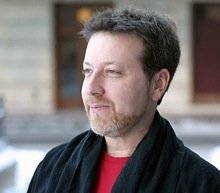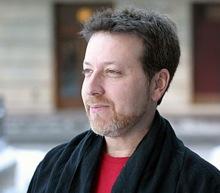
The concert, conducted by Brad Lubman, included a piece by Lachenmann himself, as well as one by another long-established composer, Brian Ferneyhough. Works by three younger composers — Oscar Bianchi, Matthias Pintscher, and Michael Jarrell — completed the program. Although the featured works all bear titles that refer to physical states, places, or objects, their affinities with nature are perhaps more abstract than they are literal. The pieces bring to mind qualities such as density and transparency, stasis and dynamism, structure and amorphousness. These vague similarities, though, hardly gloss over the diversity of these works.
Opening the program was Michael Jarrell’s ...more leaves... (2000), a work for solo viola, five instruments, and electronics. Its name refers to an earlier viola concerto by Jarrell, called From the Leaves of Shadow, which exploits the dark, shadowy colors of the solo instrument. The electronics of this piece, which imitate the soloist, augment those colors, or provide “more leaves.” The work culminates with an unaccompanied viola solo, and in the hands of violist Nanci Severance, it sounded both expressive and furiously virtuosic.
The name of Bianchi’s Zaffiro (“Sapphire,” 2005), a quartet for bass flute, baritone sax, guitar, and viola, was selected, in part, because the gems can be found in metamorphic rocks. Such rocks are formed by the transformation of other rocks, and Bianchi notes that his piece similarly emphasizes alternation between stasis and movement. Of course, the musical analogues to the two types of immobile rock could be chronologically separated passages of relative stasis. Yet these passages are also formed by sustained pitch, on the one hand, versus pregnant silence, on the other. I had never before heard a piece by Bianchi, who attended the performance, but after hearing Zaffiro, I will be sure to hear many more.
Rising to Meet the Curve
The instruments in Lachenmann’s Trio fluido (1966/68) are viola, clarinet, and percussion. The composer has described the work’s form as a curve that both rises and falls. I suspect the fluido of the title is intended to refer either to this flexible shape, or to the fact that even moments of repose tend to subtly evolve. Listening to this performance, though, I was struck by how the instruments — string, wind, percussion — sometimes sound quite distinct. At other times, though, as during a shared, pianissimo glissando, they flow smoothly together.Opening the concert’s second half was Pintscher’s percussion solo, another lower-case piece titled nemeton (2007), performed by Christopher Froh. The title alludes to a ceremonial place for druids in Celtic mysticism. According to Pintscher, it is also a “place of captivated energy.” His energetic piece calls for a daunting range of percussion instruments, including blocks, suspended cymbals, a bass drum, hanging metal instruments, and marimba. Froh’s navigation of these instruments was impressive, both aurally and visually. Equally wide-ranging were the methods used for striking these instruments. They extended from the usual mallet attacks to delicate finger-taps. In my favorite passage, Froh played the marimba with his hands like a frenetic, mad pianist.
Finally, Ferneyhough’s Flurries (1998) is a work for six instruments. The composer has cited a particular line from an eponymous poem by A.R. Ammons, which inspired the piece: “... but motion undermines meaning with meaning.” At least to me, the line evokes a paradoxical, constant state of unrelenting transition. Similarly, the musical shapes of this piece seem to be in constant flux. They sound so overwhelmingly fast and complicated that collectively they seem like a high-speed train whizzing by as an indistinct, yet commanding, blur. Nonetheless, the musical shapes also require great precision and coordination from the players, and Monday’s performers met that challenging demand.
Conductor Lubman compared his experience with learning Flurries especially to the process by which a foreign language becomes familiar. Reasonably, no single performance of these works, which are as difficult to perform as they are complex to hear, could encapsulate that same experience in its entirety for an audience. Yet the unflinching skill with which the Contemporary Music Players performed these pieces made the works seem, like the unknown depths of an ocean, teeming with vitality, as well as intriguing and inviting to explore over and over again.

